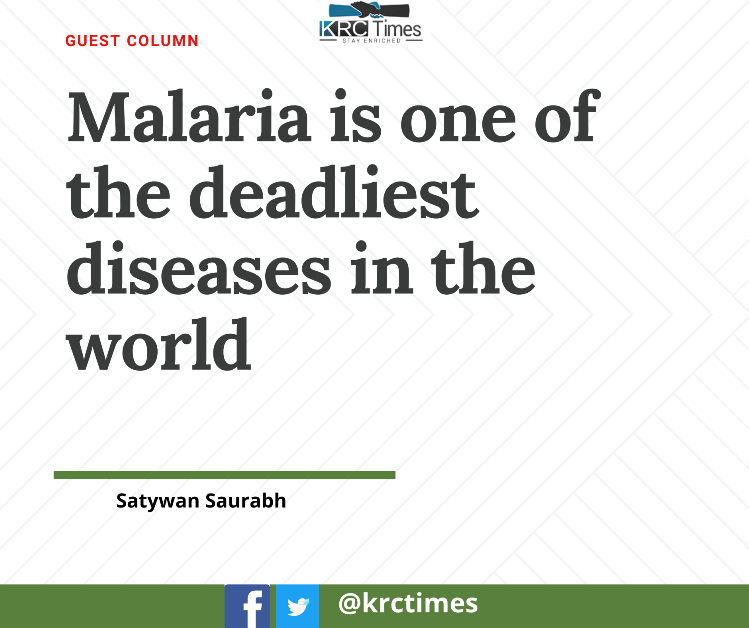The plan provides a roadmap to achieve the goal of eliminating malaria in 571 of India’s 678 districts by 2022
 Satywan Saurabh
Satywan Saurabh

World Malaria Day 2022 is being observed by the World Health Organization (WHO) on 25 April with the theme ‘Using innovation to reduce the burden of malarial disease and save lives. World Malaria Day was established on 25 April 2007 by the World Health Organization at the 60th session of the World Health Assembly. Malaria is caused by a parasite that is usually carried by the deposition of parasitic sporozoites in the skin of humans by a certain type of mosquito, the female Anopheles. Malaria is a major cause of human mortality. According to the World Health Organization (WHO), there are 212 million new cases of malaria and 430,000 malaria-related deaths worldwide each year, despite enormous progress in tackling the disease.
Malaria is an acute febrile disease. In a non-immune person, symptoms usually appear 10-15 days after being bitten by an infected mosquito. The first symptoms – fever, headache, and chills – may be mild and difficult to recognize as malaria. If left untreated within 24 hours, falciparum malaria can turn into a serious illness, often leading to death. Children with severe malaria often develop one or more of the following symptoms: severe anemia, respiratory distress about metabolic acidosis, or cerebral malaria. In adults, multi-organ failure is also frequent. In malaria-endemic areas, people may develop partial immunity, leading to asymptomatic infection.
Malaria has been one of the deadliest diseases in the world. It kills more than 400,000 people worldwide each year and causes disease in millions. Africa is home to 70% of the world’s malaria cases and 90% of deaths. Over the past two decades, existing interventions have reduced the burden of malaria. And India has also made good progress in malaria control. The disease burden has come down by 59 percent. This success has prompted the government to commit to eliminating malaria by 2030. The majority of malaria cases were reported from the African region (93%), followed by the South-East Asia region (3.4%) and the Eastern Mediterranean region (2.1%). India and nineteen countries in sub-Saharan Africa accounted for 85 percent of the global malaria burden, with six countries accounting for more than half of the global malaria cases. The countries included Nigeria (25%), the Democratic Republic of the Congo (12%), Uganda (5%), Cte d’Ivoire, Mozambique, and Niger (4% each).
Vector control is the main method of preventing and reducing malaria transmission. If the coverage of vector control interventions within a specific area is high enough, a measure of protection will be provided throughout the community. WHO recommends protection for all people at risk of malaria with effective malaria vector control. Two forms of vector control – insecticide-treated mosquito nets and indoor residual spraying – are effective in a wide range of conditions. Mosquirix is the first and so far only vaccine approved by the World Health Organization that has shown potential to reduce malaria and life-threatening severe malaria in trials on young African children. The vaccine works against falciparum, the deadliest malaria parasite globally, and most prevalent in Africa. It is also the first malaria vaccine to be offered by three national health ministries through their childhood immunization programs – Ghana, Kenya, and Malawi.
India’s progress in fighting malaria is the result of concerted efforts to ensure that its malaria program is country-owned and country-led, even if it is in line with globally accepted strategies. The Government of India has released a National Strategic Plan (NSP) for malaria eradication for the year 2017-2022, with a target of eradication by 2030. This has led to a shift in focus from malaria “control” to “elimination”. marked. The plan provides a roadmap to achieve the goal of eliminating malaria in 571 of India’s 678 districts by 2022.
There has been a significant decline in malaria cases in India, with the number falling to 5.1 million in 2018, from 9.6 million a year ago. According to the World Malaria Report 2018, it declined by 24% in 2017. Since 2000, India has reduced malaria deaths by two-thirds and halved the number of malaria cases. India saw a 28 percent drop in malaria cases between 2017 and 2018. In the period 2016 and 2017, India recorded a 24 percent reduction in malaria cases. Furthermore, only seven of the 28 Indian states and 9 union territories accounted for 90 percent of the estimated malaria cases in 2018. These states included West Bengal, Jharkhand, Chhattisgarh, Odisha, Madhya Pradesh, Uttar Pradesh, and Gujarat.
All seven states reported a significant reduction in malaria cases, from 14.3 million cases in 2010 to 5.7 million cases in 2018. The rate of reduction in the last 3 years was mostly slow compared to other countries in the last 3 years. Among the states, Odisha’s Durgama Anchalre Malaria Mitigation Initiative is significant. The objective of this initiative is to provide services to the most remote and hardest-hit people of the state. The initiative has in-built innovative strategies to tackle asymptomatic malaria. The program is jointly implemented by the Indian Council of Medical Research-National Institute of Malaria Research, National Vector Borne Disease Control Program, Odisha, and Medicines for Malaria Venture.

Satyavan ‘Saurabh’, is a Research Scholar, Poet, Independent Journalist, Columnist, All India Radio and TV Panelist
Advertisements | 5E For Success






